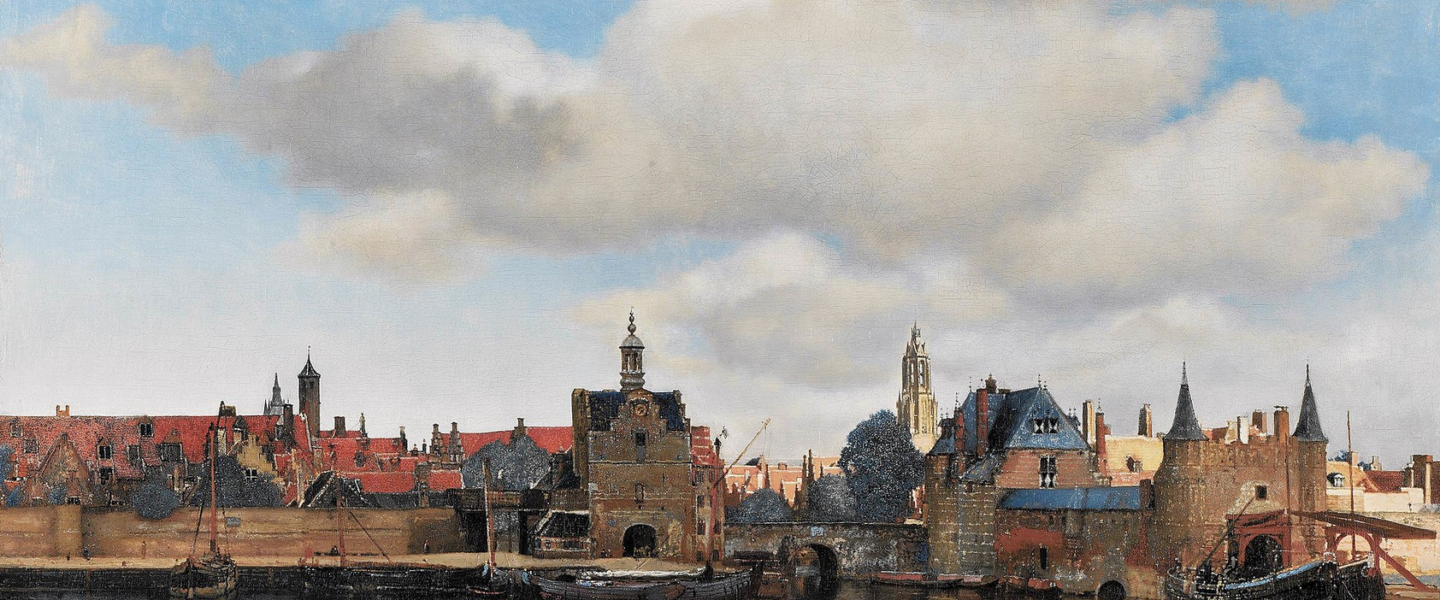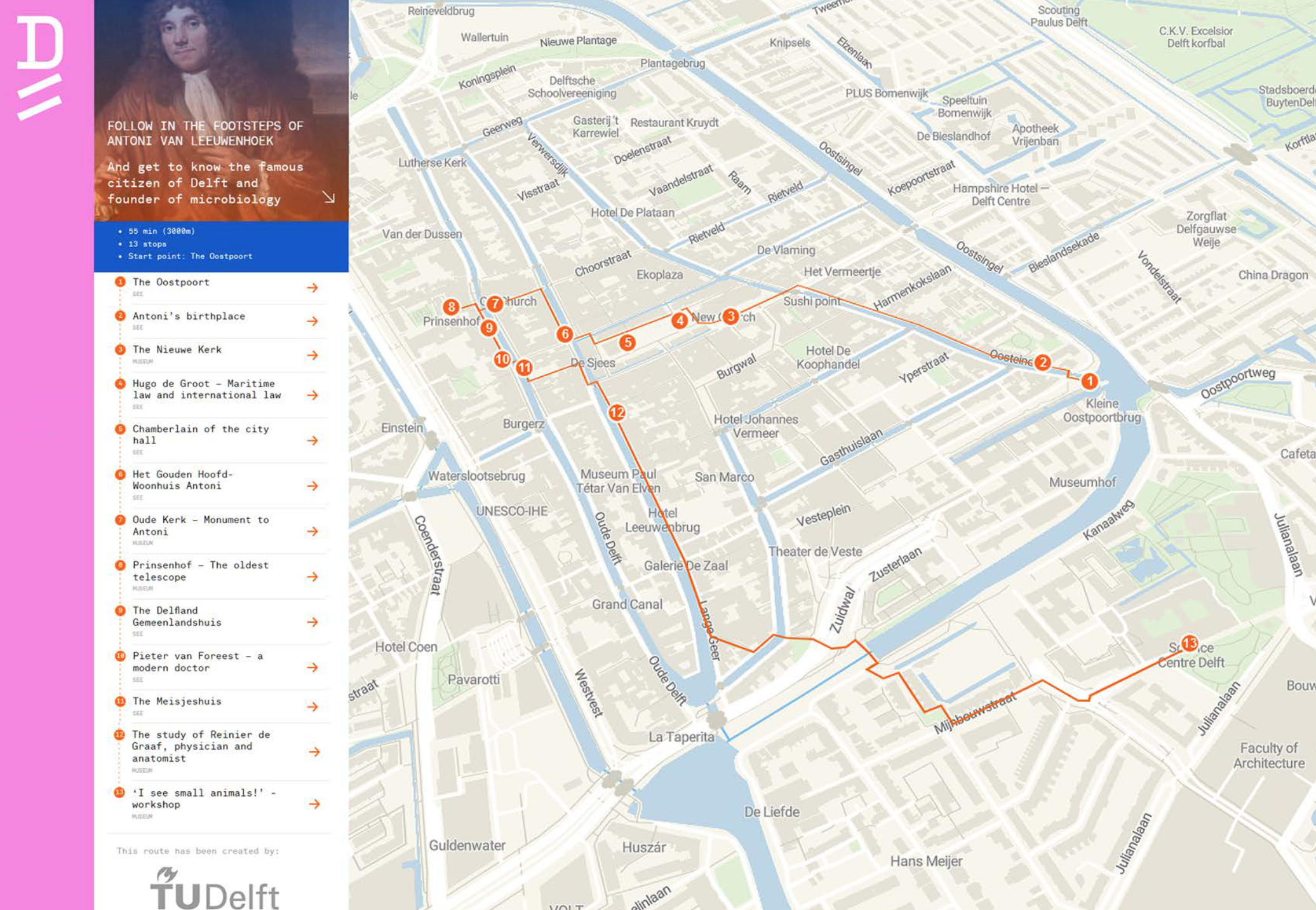
1 januari
t/m 31 december
Wandel in de voetsporen van Antoni van Leeuwenhoek door de binnenstad van Delft
Wetenschap in de 17e eeuw
Laten we een stap terug in de tijd nemen, naar de tijd dat de Republiek der Zeven Verenigde Provinciën een bloeiende handel doormaakte. Delft was de thuisbasis van een kantoor (kamer) van de Verenigde Oost-Indische Compagnie, het eerste beursgenoteerde bedrijf ter wereld; de schilderijen van kunstenaars als Johannes Vermeer en Pieter de Hooch; en een ontluikende wetenschappelijke wereld met personen als Hugo de Groot en Reinier de Graaf. Er was hier een groeiend en bloeiend netwerk van wetenschappers en kunstenaars.
De grondlegger van de microbiologie Antoni van Leeuwenhoek (1632-1723) deed zijn wetenschappelijk onderzoek naast het dagelijkse werk waarmee hij zijn brood verdiende. Met zelfgebouwde microscopen ontdekte hij als eerste onder meer bacteriën en spermatozoïden. Hij was de grondlegger van de microbiologie. Deze wandeling voert je langs de hoogtepunten van Delft in de Gouden Eeuw, het decor van de wetenschappelijke revolutie mede door Van Leeuwenhoek gestart.
https://www.delft.com/routes/follow-in-the-footsteps-of-antoni-van-leeuwenhoek
Science in the 17th century
Let’s step back in time, to when the Republic of the Seven United Provinces was experiencing a boom in trade. Delft was home to an office (chamber) of the Dutch East India Company, the first listed company in the world; the paintings of artists such as Johannes Vermeer and Pieter de Hooch; and the world of science of figures such as Hugo de Groot and Reinier de Graaf. There was a network of scientists and artists.
The founder of microbiology
Antoni van Leeuwenhoek (1632-1723) did his scientific research alongside the everyday work with which he earned his living. Using microscopes he built himself, he was the first to discover bacteria and spermatozoids, among other things. He was the founder of microbiology.
This walk takes you past the highlights of Delft in the Golden Age, the setting of the scientific revolution started partly by Van Leeuwenhoek.
https://www.delft.com/routes/follow-in-the-footsteps-of-antoni-van-leeuwenhoek
Don’t Miss!
In addition to the dozen locations related to Leeuwenhoek on the map below, some others are worth noting.
The Waag
Right behind the Stadhuis (5) is the Waag, the weighing house. During the 17th century, it handled everything that came into or left Delft on a boat, including wine. For more than three decades, Leeuwenhoek worked in the Waag as Delft’s wine gauger, responsible for collecting the city’s excise taxes on imports and exports of wine. The Waag is now a restaurant.
The Comanscolff
Around the corner from the Waag at Oude Langendijk 7 is a monumental building, in Leeuwenhoek’s time called the Comanscolff. On the facade is a plaque with crossed golf sticks and the year it was built, 1641. The crossed sticks were the sign of the St. Nicolaas-, Marskramers- of Koopliedengilde, to which Leeuwenhoek belonged from 1655 until 1697, long after he had closed his draper’s shop. The guild members held an annual dinner at the Comanscolff on 6 December, St. Nicholas’ Day, that was compulsory in the sense that members paid a fine for missing it. The Comanscolff is now a shop selling home furnishings.
Leeuwenhoek’s house: Het Gouden Hoofd
The house that Leeuwenhoek lived in for his whole adult life, called the Gouden Hoofd (golden head) was on the west side of the Hippolytusbuurt, the second house from the corner of the Nieuwstraat. In the early 1800s, het Gouden Hoofd was incorporated into the house on the corner, the Zuikerhuis. For most of the 20th century, it was a Vroom en Dreesman department store. It is now a restaurant, the northern portion of which was Leeuwenhoek’s draper’s shop and later the room where he received visitors. Directly above it is the window (fourth from the corner) to his comptoire, the small room where he did most of his work. The third and fourth houses, now a Bakker van Mannen, were called the Rode Zee and the Nieuwe Vischmart. The plaque that reads “Hier stond het huis ‘Het Gouden Hoofd'” is on the facade of the Nieuwe Vischmart.

Meer evenementen
1 januari
t/m 31 december
Wandel in de voetsporen van Antoni van Leeuwenhoek door de binnenstad van Delft
15 februari
t/m 31 mei
Eén vierkante meter natuur
14 april
Verlichte Geesten: Huygens, Descartes en Van Leeuwenhoek - tijdgenoten en geestverwanten
18 april
t/m 7 januari
Tentoonstelling "Onvoorstelbaar" in Rijksmuseum Boerhaave in Leiden
21 april
‘Kleine Dierkens’ Uit de 17de Eeuw in museum Allard Pierson Amsterdam
29 april
t/m 7 mei
Maak een petrischaal kunstwerkje
29 april
t/m 7 mei
Ondergedompeld in het kleine; bezoek ons micro-festival
6 mei
t/m 16 december
Microscopie Workshops bij kunstcentrum RADIUS Delft
20 mei
De onvoorstelbare microscopische ontwikkelingen van de laatste eeuw en het hedendaagse onderzoek
22 mei
t/m 29 mei
Week van de Biologie
10 juni
Visualizing the Unknown: 17de-eeuwse microscopische waarneming en visualisatie getoetst met historische instrumenten
1 juli
De rookgordijnen van Van Leeuwenhoek
26 augustus
t/m 31 oktober
Ontdek het Delft van Antoni
28 augustus
t/m 28 oktober
KOM KIJKEN - Tentoonstelling
28 augustus
t/m 28 oktober
Botanische overlevers - Tentoonstelling + workshop
28 augustus
t/m 31 oktober
De groene lens van van Leeuwenhoek
30 augustus
t/m 11 oktober
Ontdek Antoni met een gids
2 september
t/m 19 november
RADICALE SYMBIOSE: HET SOCIALE LEVEN VAN MICROBEN
14 september
t/m 15 september
Antoni van Leeuwenhoek and his impact on the history of microscopy
22 oktober
t/m 22 oktober
Science Day 2023 - thema Microbiologie - Het gratis familie-event van de TU Delft
28 oktober
t/m 28 oktober
Lezingenreeks op de slotdag van tentoonstelling KOM KIJKEN
